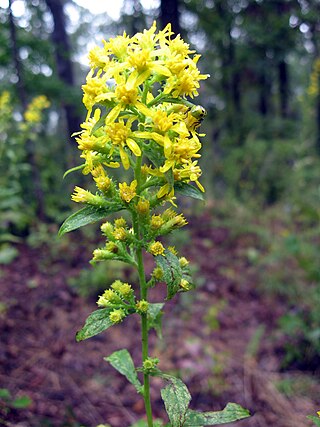
Eriophyllum lanatum, with the common names common woolly sunflower, Oregon sunshine and golden yarrow, is a common, widespread, North American plant in the family Asteraceae.

Vernonia is a genus of about 350 species of forbs and shrubs in the family Asteraceae. Some species are known as ironweed. Some species are edible and of economic value. They are known for having intense purple flowers. There have been numerous distinct subgenera and subsections named in this genus, and some botanists have divided the genus into several distinct genera. For instance, the Flora of North America recognizes only about twenty species in Vernoniasensu stricto, seventeen of which are in North America north of Mexico, with the others being found in South America.

Packera obovata, commonly known as roundleaf ragwort, spoon-leaved ragwort, roundleaf groundsel, or squaw-weed, is an erect perennial herb in the Asteraceae (aster) family native to eastern North America. It was previously called Senecio obovatus. Basal and lower leaves are obovate with toothed margins, while upper leaves are pinnately divided. The ray flowers are yellow and the disk flowers orange-yellow, the inflorescences being held well above the foliage.

Liatris aspera is a perennial wildflower in the Asteraceae family that is found in central to eastern North America in habitats that range from mesic to dry prairie and dry savanna.

Vernonia noveboracensis, the New York ironweed or vein-leaf hawkweed, is a plant in the family Asteraceae. It is native to the eastern United States, from Florida to Massachusetts and west to Tennessee, Alabama, and West Virginia and to southern Ontario.

Eupatorium altissimum, with the common names tall thoroughwort and tall boneset, is a perennial herbaceous plant in the Asteraceae family with a native range including much of the eastern and central United States and Canada. It is a tall plant found in open woods, prairies, fields, and waste areas, with white flowers that bloom in the late summer and fall.

Symphyotrichum sericeum is a species of flowering plant in the family Asteraceae native to central North America. Commonly known as western silver aster, western silvery aster, and silky aster, it is a perennial, herbaceous plant that may reach 70 centimeters tall. Its flowers have purple ray florets and pink then purple disk florets, and its leaves are firm and silvery-green.

Balsamorhiza sagittata is a North American species of flowering plant in the tribe Heliantheae of the family Asteraceae known by the common name arrowleaf balsamroot. Also sometimes called Oregon sunflower, it is widespread across western Canada and much of the western United States.

Enceliopsis covillei, known by the common name Panamint daisy, is a rare North American desert species of flowering plant in the family Asteraceae.

Nothocalais troximoides is a species of flowering plant in the family Asteraceae known by the common name sagebrush false dandelion. It is native to western North America, including British Columbia and the northwestern United States.

Vernonia gigantea is a species of perennial plant from family Asteraceae found in United States and Canada. The plant is native to the eastern United States, north to New York state and Ontario, and southwest to Texas.

Vernonia missurica, the Missouri ironweed, is a species of magenta-flowered perennial plant from family Asteraceae native to the central and east central United States.

Solidago buckleyi, or Buckley's goldenrod, is a species of goldenrod native to central North America. It is an uncommon species with a small range, being found mainly in the Ozark Mountains of Arkansas and Missouri, and in the uplands near the confluence of the Ohio and Mississippi Rivers near southern Illinois and western Kentucky. There are also a few isolated populations reported from Indiana. Its preferred habitat is open oak woodlands.

Helianthus decapetalus, known by the common names thinleaf sunflower and thin-leaved sunflower, is a perennial forb in the family Asteraceae. It is native to the Eastern and Central United States and Canada, from New Brunswick west to Iowa, Wisconsin, and Ontario, south as far as Georgia and Louisiana. It produces yellow composite flowers in late summer or early fall.

Vernonia lettermannii, the narrowleaf ironweed, is a plant species known only from Arkansas and Oklahoma. It grows on floodplains and terraces at elevations of 100–200 m (330–660 ft).

Solidago hispida, the hairy goldenrod, is North American species of flowering plants in the family Asteraceae. Its native range extends from Newfoundland west to Saskatchewan, and south as far as Oklahoma, Louisiana, and Georgia.

Solidago latissimifolia, common name Elliott's goldenrod, is North American species of flowering plants in the family Asteraceae. It is native to the Atlantic Coast of the United States and Canada, from Nova Scotia south to Alabama and Florida.

Solidago radula, the western rough goldenrod, is a North American plant species in the family Asteraceae. It is found primarily in the southern Great Plains and the Mississippi Valley of the United States, with isolated populations farther east in Kentucky, Georgia, and the Carolinas.

Verbesina helianthoides, commonly called yellow crownbeard or gravelweed, is a species of flowering plant in the family Asteraceae. It is native to the United States, where it is primarily found in the Upper South and South Central areas. Its natural habitat is in communities that receive ample sunlight, such as open woodlands, prairies, and glades.

Vernonia fasciculata, the smooth ironweed or common ironweed, or prairie ironweed is a species of perennial plant in the family Asteraceae. It is native to Manitoba in Canada and the north-central U.S.A.





















